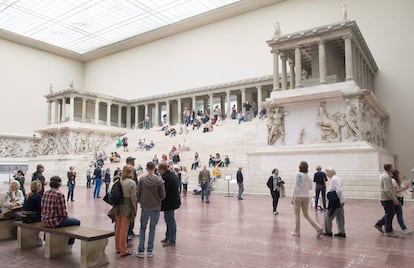Who does art belong to?
Some of the world’s major museums are refusing to return masterworks to countries that were victims of historical plundering

The history of art is, in large part, the history of plunder. Vikings, conquerors, Napoleon, colonial powers, Hitler... they all pillaged art on a monumental scale. The French colonial army helped transport tons of Egyptian artworks to Europe. Around the same time, the British shipped over the Greek Parthenon Marbles. Later, as part of the Benin Expedition of 1897, British troops pillaged all the art – including the Benin Bronzes – from the palaces of the African kingdom. The collections of the Louvre in Paris, the British Museum in London and the Neues Museum in Berlin have all been enriched by this plunder.

But the story doesn’t end there. Countries, whether they were once invaded territories or former colonies, are demanding their treasures be returned to them, and with them their identity. Since 1934, Turkey for instance has demanded Berlin’s Pergamon Museum return two sphinxes that were taken from Hattusas, the capital of the Hittites empire. Fed up after over 80 years of inaction, the Turkish government has created a commission to trace its stolen patrimony.
Holding onto antiquities through punitive campaigns is an intolerable continuation of colonial violence
Archeologist Sam Hardy
The governments of Aragon and Catalonia are in a similar face-off over the treasures of Sijena, a 12th-century monastery in Huesca. Spain has also come under attack from countries such as Colombia, which has demanded the return of the Quimbaya treasure, a collection of 122 gold pieces that president Carlos Holgín gifted to the country in 1893.
We live in a time in which the great Western museums heavily protect their patrimony and think little about restitution. They excuse this attitude arguing that they take better care of the works. “When works are on display and accessible to the public this helps diffuse questions over ownership because what is important is that they can be seen by as many people as possible,” says Gabriele Finaldi, director of the National Gallery in London.

This thinking falls in line with the idea that the art should be shown there because more people can enjoy it. But there is another side of the argument. “The ethical and legal circulation of cultural goods benefits the country where they come from,” argues archeologist Sam Hardy. “Holding onto antiquities that have been stolen through punitive campaigns is an intolerable continuation of colonial violence.” It seems impossible for these two sides to find a happy meeting point.
French public collections are considered “inalienable” and cannot be given away
Meanwhile, Greece continues to wait for the Parthenon marbles to be returned to Athens. A museum has been built to house the works and even the British public are in favor. But it makes no difference. The British Museum has slammed the door. “Until the museum changes its board, who all come from the ‘establishment,’ it is unlikely we will see a different position,” says Tom Flynn, member of the British Committee for the Reunification of the Parthenon Marbles.
But there is still hope. This week, French President Emmanuel Macron announced that over the next five years he would work on creating the conditions needed to “temporarily or permanently” return the African patrimony taken from former French colonies. In the Quai Branly-Jacques Chirac Museum in Paris alone there are 70,000 works from Sub-Saharan Africa. Some believe this could encourage other countries to reclaim their stolen heritage. “It sends a dangerous signal to all countries (former colonies but also Greece and Egypt) that have works that, in their opinion, have been illegally taken. Now they can reclaim them,” says Yves-Bernard Debie, a lawyer specializing in cultural property. But before Macron can fulfill his plan he has to change the law, because French public collections are considered “inalienable” and cannot be given away. Just like in Spain. “We’re pretty lucky,” says Andrés Úbeda, assistant director at the Conservation and Investigation of Madrid’s Prado Museum, “because we’re not affected by the two most contentious issues: colonial and Nazi pillaging.”
Ownership vs. custodianship
Countries are, for now, becoming more entrenched over their cultural legacies. Perhaps it’s due to the resurgence of nationalism, or the skyrocketing value of artwork. But emphasizing ownership dilutes what is truly precious in art. “Art is a manifestation of the people. It is not private or public. It is like water, or the forests,” says Manuel Borja-Villel, director of the Reína Sofía Museum in Madrid. “We need to swap the concept of ownership for that of custodianship,” he adds.
But the world is becoming increasingly protective of its treasures. Italy is calling for an export permit for works that are older than 50 years, Sicily charges those who want to borrow Caravaggio’s paintings and Germany demands a special permit before allowing canvases valued over €150,000 to be taken out of the European Union. Protectionism has become part of the art world and led to new ways of possessing it.
“Masterpieces from the ancient world belong to everyone. But in a culture based on property instead of common rights, there are interminable disputes over ownership,” says Jason Felch, an expert in antiques trafficking. Perhaps we should remember that big museums keep around 90% of their works in the basement. “Finding new stories in our collections, offering visibility to the forgotten and hidden is a very different kind of possession, one that is less materialistic and more poetic,” says Miguel Zugaza, director of the Bilbao Fine Arts Museum. Today, these words sound like a song unsung.
Art backs microcredits
There are two competing forces in the world of art. A centrifugal force that pushes works out from their place of origin, and a centripetal force that demands they stay. The Culture Bank (founded in Mali in 1995 by the activist Todd Crosby) belongs to the latter. It helps create local museums to help countries from the most disadvantaged parts of the world retain their cultural patrimony. The locals are invited to showcase works from their family. With these pieces they can also ask for small loans.
English version by Melissa Kitson.
Tu suscripción se está usando en otro dispositivo
¿Quieres añadir otro usuario a tu suscripción?
Si continúas leyendo en este dispositivo, no se podrá leer en el otro.
FlechaTu suscripción se está usando en otro dispositivo y solo puedes acceder a EL PAÍS desde un dispositivo a la vez.
Si quieres compartir tu cuenta, cambia tu suscripción a la modalidad Premium, así podrás añadir otro usuario. Cada uno accederá con su propia cuenta de email, lo que os permitirá personalizar vuestra experiencia en EL PAÍS.
¿Tienes una suscripción de empresa? Accede aquí para contratar más cuentas.
En el caso de no saber quién está usando tu cuenta, te recomendamos cambiar tu contraseña aquí.
Si decides continuar compartiendo tu cuenta, este mensaje se mostrará en tu dispositivo y en el de la otra persona que está usando tu cuenta de forma indefinida, afectando a tu experiencia de lectura. Puedes consultar aquí los términos y condiciones de la suscripción digital.
More information
Archived In
Últimas noticias
Most viewed
- Sinaloa Cartel war is taking its toll on Los Chapitos
- Oona Chaplin: ‘I told James Cameron that I was living in a treehouse and starting a permaculture project with a friend’
- Reinhard Genzel, Nobel laureate in physics: ‘One-minute videos will never give you the truth’
- Why the price of coffee has skyrocketed: from Brazilian plantations to specialty coffee houses
- Silver prices are going crazy: This is what’s fueling the rally










































